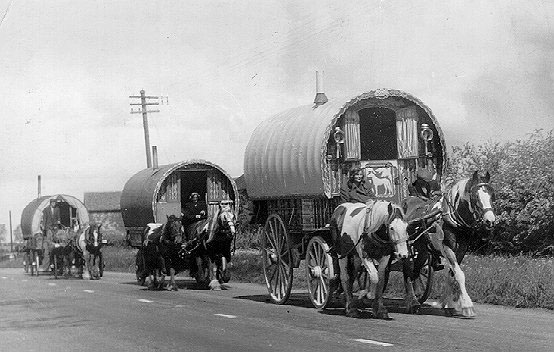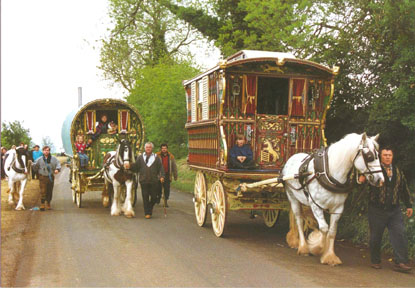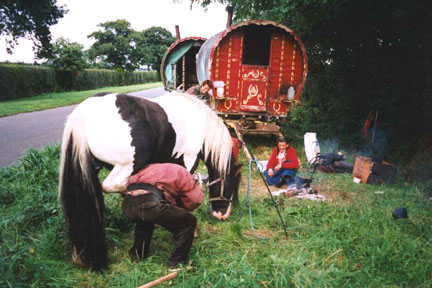Traveling within the World
Linking your favorite traveling artists across the globe
A Bit About the Travellers and Their Horses...
| Origins of the Breed ... |
|
| The brightly-colored heavily-feathered horse gets it's name due to the simple fact that it is a horse bred and owned by the gypsies. It is called Gypsy Horse, Gypsy Cob, Gypsy Vanner, Irish Cob, Coloured Cob, Tinker Horse, and Romany Horse to name a few. There is much speculation as to the origins of the "Gypsy Horse" and there are varying opinions as to what breeds were used to create the horse of today. Most agree that the ancestors of the Gypsy Horse were cold-blooded. Often you will hear that Shire and Clydesdale provided the bone and feather and Dales Pony or Fells Pony provided the smaller stature. Some suggest that there is Trotting Horse influence as well, improving upon the endurance of the draft breeds. It has also been said that the Friesian breed and a pacing breed known as the Gallower may well be involved in the make-up of the Gypsy Horse. What is known is that the Travellers have developed and maintained this breed of horses over hundreds of years. Through selective breeding they have created a breed of horse that is not duplicated anywhere else in the world. Theirs is a small, hardy draft horse with flamboyant color and feather, and a calm and intelligent personality. Thanks to their rich tradition of oral history the owners of these horses can often trace their pedigree back through the years. |
|
Possible Background Breeds Of The Gypsy Horse... |
|
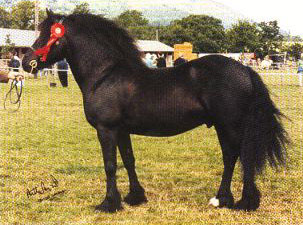 Dales Pony Photo courtesy of Dales Pony Society |
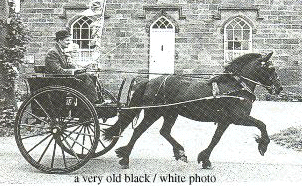 Old Photo of Dales Pony in Harness Photo courtesy of Dales Pony Society |
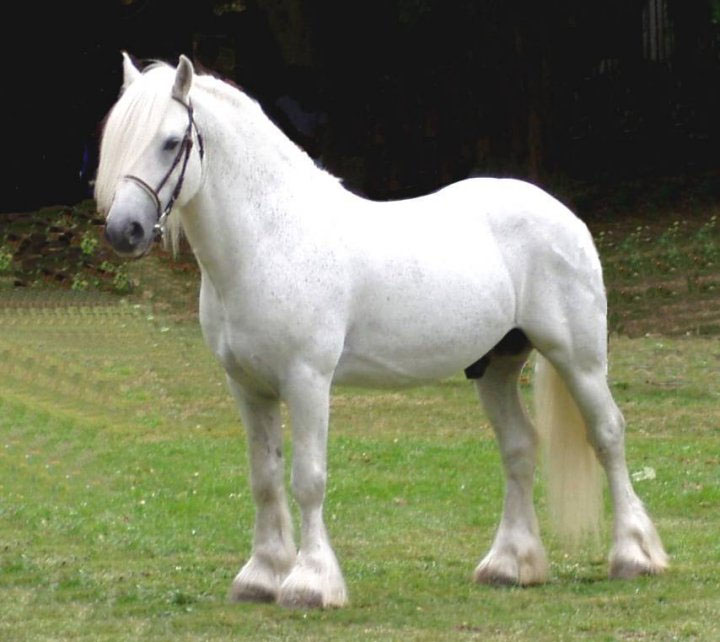 Fell Pony Stallion Lunesdale Mountain Mist Photo courtesy of Fell Pony Society |
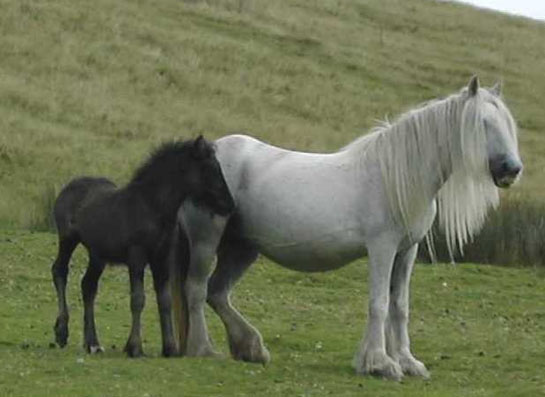 Fell Pony Mare and Foal Photo courtesy of Fell Pony Society |
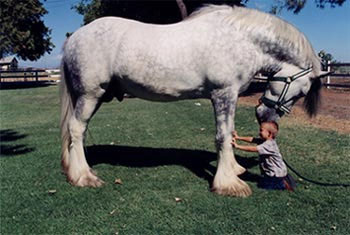 Shire Stallion |
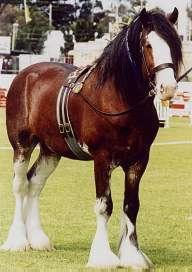 Clydesdale Stallion |
Development of the Breed... |
|
The following information from the folks at Harlequin Farms does a nice job of explaining the early development of the breed: "Early Gypsies soon discovered what was necessary in the horses they owned and used. They had to be strong enough to pull their caravans and caravans weighed an enormous amount. Just imagine the weight, not only of the caravan itself, but the fact that it carried everything the entire family owned. All clothing, pots and pans, dishes, linens and most even had pot belly and/or cooking stoves. Most caravans weighed so much, that everyone except the very young and elderly, walked beside them as they journeyed from one place to another. Often, just the women actually "drove" and the men walked alongside to their next possible source of income or campsite for the night. So to be able to pull all this, their horses had to have solid, weighty bodies, huge bone, thick necks and a great layback of shoulder. They had to have strong legs and large feet. They had to be unflappable in any situation and absolutely solid and reliable in their interaction with humans, including children. They had to be tough enough to exist in the harshest of weather and often on meager food sources. They had to be able to pull a caravan all day if necessary covering sometimes 40 miles or more on hard roads or muddy lanes. They had to have a willing "work ethic" and always do what was required of them. In the past, most existed on what was found growing along country roads when the family camped for the night so they had to be what we refer to today, as "easy keepers". |
|
The following piece is from the Gypsycob.co.uk site explaining the effects of WW War I on the development of Gypsy Horses: "During the First World War a lot of the horses in the Uk were bought by the Army and taken overseas, all sizes and shape of horse were utilized to pull canons, carry regiments into battle and carry injured from the fronts. The only type of horse the Army did not want to buy was the COLOURED horse, obviously these would not be very good in camouflage ! The Romany Gypsy, ever resourceful, had available an abundance of cheap, colorful, easily recognizable horses. They had been using horses to travel across Europe for centuries and some settled to traveling in England and Ireland. In England we have our own native breeds, which used to roam freely across certain parts of the country, such and the Fells and Dales of North England." "Romany Gypsy's favored the flashiness and availability of the colored horse, the feather, hair and steady, hardworking nature of the heavy breeds, and needed the sturdy, compact, sure footed bodies of the Fell and Dales ponies. They continued breeding their horses using this mix of breeds, adapting their preferred size and build to suit their particular needs and likes. This continued and flourished as the Gypsies strived to have the best horse they could, that did the best job it could to fit in with their way of life. The Gypsy also liked the fact that the colored horse is easily recognized and could not be 'swapped' as easily as some solid colored horses!" "One thing they will not tolerate was a bad tempered horse. All animals in a Gypsy family have to be totally safe with all the family." "This selective breeding eventually diversified the Gypsy Cob into four categories. Up to 14.2hh, short, stocky, compact ponies used for pulling working flat carts. Up to 15hh big, powerful cobs used for pulling the living wagons and heavier loads. Over 15hh cobs with more Shire/Clydesdale blood, used for heavy loads and agricultural work. The Trotter, cobs usually crossed with Standardbred horses, used for road racing in Sulkie traps." "The Romany people were, and still are dedicated, knowledgeable and skilful in breeding their own type of horse, even though they came up against severe discrimination against there way of life, their horses were almost expelled from the equine world." "But, now the Romany has within its own tight knit community one of the most popular and sought after horses in the world, and they are rightly, quietly pleased with themselves." |
|
|
|
Tags:
Replies to This Discussion
-
Permalink Reply by Dept of PMM Artists & things on February 22, 2011 at 12:31pm
-
Then:
The Gypsy dream was to breed the perfect horse to pull their colorful vardos or living wagons through the hillsides of England and Ireland. The Gypsy Vanner had to be strong and athletic so that they could manage the heavy vardos with the Gypsy family and his belongings. The horses had to be hardy and easy to keep, as they were often tethered on the side of the road or in fields, eating whatever grass they could find and living without shelter in the cold winters. And when the days work was done, the beautiful Gypsy Vanner, had to be gentle and docile enough to teach Gypsy children how to ride.
While most Gypsies do not live in vardos any longer, they still keep and breed quality Gypsy Vanner horses. Now, as in the traveling days, the Gypsy Vanner is a symbol of status, and a source of great pride among the Romany Gypsies.
Now:
Until now, the Gypsy Vanner was not a registered breed. While the breeding of these magical horses was careful and deliberate, the detailed history of the breed bloodlines, was kept in the collective memory of the families who bred them for many generations. Due to the recent interest and importation of Gypsy horses, registries are being established here and abroad to protect and continue the established bloodlines. Many names are associated with a gypsy type horse; Cob, Coloured Horse or Tinker. Gypsy families often own many gypsy type horses, but there are only a few that possess the potential to reproduce the quality of horse that is most sought for breeding purposes. Enter the Gypsy Vanner - The word Vanner simply means "caravan" and is a registered trademarked name for the promotion of Gypsy Vanner Horses by The Gypsy Vanner Horse Society . The Gypsy Vanner Horse must possess a certain look and meet a clear conformation standard, ensuring that we may reproduce the same quality horse that the ancient Romany Gypsy dreamed of.
The sheer beauty of the Gypsy Vanner will captivate both young and old alike. Bred from a combination of draft and pony breeds they range in size from 13-15 hands. They are sturdy horses with heavy bone, flat knees and a short back. They come in a variety of colors; bay/white, red/white, blue and tri-colored. The most common color is black/white and occasionally you will find a solid color, however, all colors are prized! Gypsy Vanners have an abundance of mane and feather. The feathers should begin at the knee/hock and fully cover the hooves. Manes and tails are long, thick and flowing. The Gypsy horse is truly magic in motion, appearing to float as they move!
The Gypsy Vanner has many wonderful qualities. Their beauty is immediately noticed, but time spent with a Gypsy Vanner and their warm, gregarious nature, is a true blessing! Years of selective breeding has developed a personality that is likely the most gentle and docile in the world. They are extremely social and eager to participate in your activities and will do so with beauty and style!
Highly admired, the Gypsy Vanner is still extremely rare in the United States, numbering around 200 at this time. Due to their increasing popularity, we expect to see many more in the very near future. Traditionally used for driving, they also excel at dressage, hunter jumper and both english & western riding.
Enchanting, incredibly versatile and with temperament that is unequaled, they will quickly become your dream of the perfect horse!
-
Events
-
2014 is the Chinese Year of the Horse
February 17, 2026 at 12am to February 5, 2027 at 12am – where & how you choose
Birthdays
There are no birthdays today
Important (read & understand)
Skype: Travelingraggyman
Email and Instant Messenger:
TravelerinBDFSM @ aol/aim; hotmail; identi.ca; live & yahoo
OR
Travelingraggyman @ gmail and icq ***

1AWARD UPDATES & INFORMATION
10,000 votes - Platinum Award
5,000 votes - Gold Award
2,500 votes - Silver Award
1,000 votes - Bronze Award
300 votes - Pewter Award
100 votes - Copper Award
Member of the Associated Posting System {APS}
This allows members on various sites to share information between sites and by providing a by line with the original source it credits the author with the creation.
Legal Disclaimer
***************We here at Traveling within the World are not responsible for anything posted by individual members. While the actions of one member do not reflect the intentions of the entire social network or the Network Creator, we do ask that you use good judgment when posting. If something is considered to be inappropriate it will be removed
Site Meter
This site is strictly an artist operational fan publication, no copyright infringement intended
Patchwork Merchant Mercenaries had its humble beginnings as an idea of a few artisans and craftsmen who enjoy performing with live steel fighting. As well as a patchwork quilt tent canvas. Most had prior military experience hence the name.
Patchwork Merchant Mercenaries.
Vendertainers that brought many things to a show and are know for helping out where ever they can.
As well as being a place where the older hand made items could be found made by them and enjoyed by all.
We expanded over the years to become well known at what we do. Now we represent over 100 artisans and craftsman that are well known in their venues and some just starting out. Some of their works have been premiered in TV, stage and movies on a regular basis.
Specializing in Medieval, Goth , Stage Film, BDFSM and Practitioner.
Patchwork Merchant Mercenaries a Dept of, Ask For IT was started by artists and former military veterans, and sword fighters, representing over 100 artisans, one who made his living traveling from fair to festival vending medieval wares. The majority of his customers are re-enactors, SCAdians and the like, looking to build their kit with period clothing, feast gear, adornments, etc.
Likewise, it is typical for these history-lovers to peruse the tent (aka mobile store front) and, upon finding something that pleases the eye, ask "Is this period?"
A deceitful query!! This is not a yes or no question. One must have a damn good understanding of European history (at least) from the fall of Rome to the mid-1600's to properly answer. Taking into account, also, the culture in which the querent is dressed is vitally important. You see, though it may be well within medieval period, it would be strange to see a Viking wearing a Caftan...or is it?
After a festival's time of answering weighty questions such as these, I'd sleep like a log! Only a mad man could possibly remember the place and time for each piece of kitchen ware, weaponry, cloth, and chain within a span of 1,000 years!! Surely there must be an easier way, a place where he could post all this knowledge...
Traveling Within The World is meant to be such a place. A place for all of these artists to keep in touch and directly interact with their fellow geeks and re-enactment hobbyists, their clientele.
© 2025 Created by Rev. Allen M. Drago ~ Traveler.
Powered by
![]()
